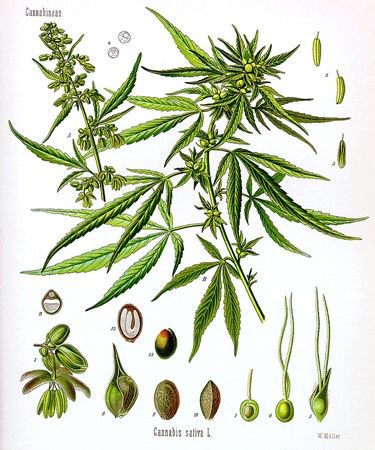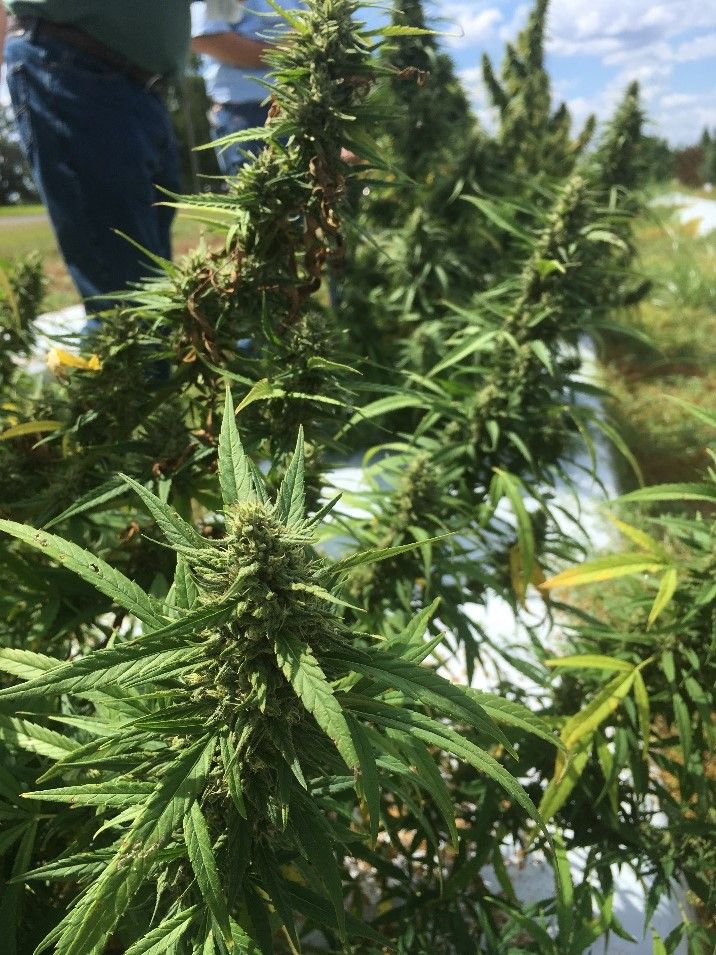Industrial Hemp in the United States: Definition and History
This publication is an educational resource on hemp for general audiences in the hemp series (https://edis.ifas.ufl.edu/entity/topic/hemp%20101%20series) with the purpose of providing knowledge about the plant, its origins, and its cultivation.
The Hemp Plant
Industrial hemp includes varieties of the botanically described species Cannabis sativa, named by Carl Linnaeus in 1753. Although the classification of the Cannabis plant genus has been debated, the current classification considers hemp and marijuana as one species (McPartland and Guy 2017). There are many wild landraces and cultivated varieties within the species C. sativa, all of which can interbreed, resulting in the single species. The operative distinction between hemp and marijuana is a legal one. Hemp is defined by law as C. sativa plants that have low levels of the psychoactive compound delta-9-tetrahydrocannabinol (THC). In Florida, as well as many other states, THC levels must not exceed 0.3% on a dry-weight basis. Marijuana is C. sativa with THC above the 0.3% threshold. The descriptors of “Indica” and “Sativa,” often used by the cannabis industries, are not reliable for botanical or legal classification.
Hemp is an annual plant that is mostly herbaceous but can also show qualities of woody stem tissue. Hemp development is short-day photoperiodic, meaning reproductive development and flowering are determined primarily by a length of nighttime darkness. Flowering occurs when nights become longer (at least 10–11 hours) or days get short (Williams 2019). Most hemp plants are dioecious, meaning there are separate male and female plants, and rarely monoecious (i.e., male and female flowers on the same plant). Oil-rich seeds, botanically achenes, are produced when a male hemp plant pollinates a female. Hemp growth and reproduction for the various end uses (fiber, oil, seed, cannabinoids) require that growers understand hemp biology to identify appropriately productive genetics.

Credit: undefined
History of Hemp
For millennia, humans have cultivated C. sativa for fiber, food, oilseed, medicine, and ritual. Archaeologists and historians have confirmed the use of hemp for fiber and food by ancient civilizations: for example, seeds in Japan in 8000 BCE (Kudo et al. 2009) and pottery with hemp fiber in China in 4000 BCE (Li 1973). Fiber from hemp was instrumental in food gathering, fishing, the domestication of animals, and other advancements important to civilization.
The specific origin of C. sativa remains uncertain because it has been spread widely throughout the world by humans. It is generally recognized to be native to Central and Southwest Asia. The plant arrived in North America in 1545 via Spanish colonization (Fike 2016). Hemp was noted as an important fiber crop in the New England colonies by the mid-1600s. Peak hemp production in the United States (US) was in the mid-1800s with temporary spikes during both World Wars. Industrial hemp production was most common in Illinois, Indiana, Iowa, Kentucky, Minnesota, and Wisconsin (Ash 1948). Feral populations of hemp have established in this region of the US, with many Midwestern states recognizing it as a noxious weed. Worldwide production decreased in the early to mid-1900s as the introduction of other fiber crops (jute, sisal, cotton), and later synthetic fibers, led to a decline in hemp demand and production.
Federal legislation, such as the 1937 Marijuana Tax Act and the 1970 Controlled Substances Act, were enacted in the 20th century, creating legal challenges for cultivation or possession of C. sativa. These laws restricted access to the plant, and prevailing market trends increased costs for hemp cultivation. These factors led to a half-century hiatus in the United States hemp industry.
Recent changes to federal law have legally distinguished hemp from marijuana and allowed the cultivation, processing, and marketing of hemp in the US. The US Agricultural Act of 2014, known as the Farm Bill, allowed hemp production under pilot projects administered by state departments of agriculture and executed by state universities. In the 2018 Farm Bill, hemp was further defined as an agricultural commodity and removed from the controlled substances list. This bill also created a pathway for the commercialization of hemp production (https://www.ams.usda.gov/rules-regulations/hemp).

Credit: Mark Tancig, UF/IFAS
Modern Cultivation and Regulation
Currently in the US, each state may administer a commercial hemp program, which defers to rules defined by the US Department of Agriculture. Florida passed a pilot project law in 2017 and a commercialization law in 2019. In Florida, farmers are issued licenses through the Florida Department of Agriculture and Consumer Services (https://www.fdacs.gov/Divisions-Offices/Plant-Industry/Hemp-Cultivation-Licensing). Other state and federal programs, such as crop insurance and production loans, are increasing in availability. Enthusiasm for hemp cultivation has resulted from the change in legal status, but markets remain unstable as regulations and industry efforts continue to develop nationwide. In modern cultivation, hemp crops are grown for fiber, seeds, and/or flowers rich in cannabinoids other than THC, such as cannabidiol (CBD). The products resulting from these various cropping systems, ranging from specialty papers to CBD products, are further described in Uses of Raw Products Obtained from Hemp: Fiber, Seed, and Cannabinoids (https://edis.ifas.ufl.edu/entity/topic/hemp%20101%20series).
UF/IFAS has developed research and Extension programs in support of the industry with ongoing efforts to collect and share information relevant for hemp farmers, such as Florida-specific production practices and suitable varieties. Producers considering industrial hemp cultivation can keep up with the UF/IFAS Hemp Program's latest information at https://programs.ifas.ufl.edu/hemp/.
References
Ash, A. L. 1948. “Hemp—Production and Utilization.” Economic Botany 2(2): 158–169. https://doi.org/10.1007/BF02858999
Bouloc, P., S. Allegret, L. Arnaud, and G. Cousquer. 2013. Hemp: Industrial Production and Uses. Wallingford, Oxfordshrine: CABI Publishing.
Cherney, J., and E. Small. 2016. “Industrial Hemp in North America: Production, Politics and Potential.” Agronomy 6(4): 58. https://doi.org/10.3390/agronomy6040058
Clarke, R. C., and M. D. Merlin. 2013. “Cannabis: Evolution and Ethnobotany.” Journal of Chemical Information and Modeling. https://doi.org/10.5091/plecevo.2014.933
Fike, J. 2016. “Industrial Hemp: Renewed Opportunities for an Ancient Crop.” Critical Reviews in Plant Sciences. https://doi.org/10.1080/07352689.2016.1257842
Garland, J. H. 2006. “Hemp; A Minor American Fiber Crop.” Economic Geography 22(2): 126. https://doi.org/10.2307/141700
Johnson, R. 2014. Hemp as an Agricultural Commodity. Washington, D.C. https://apps.dtic.mil/docs/citations/ADA599368
Kudo, Y., M. Kobayashi, A. Momohara, T. Nakamura, S. Okitsu, S. Yanagisawa, and T. Okamoto. 2009. “Radiocarbon Dating of the Fossil Hemp Fruits in the Earliest Jomon Period from the Okinoshima Site, Chiba, Japan.” Japanese J. Hist. Bot. 17:27–32.
Li, H. L. 1973. “An Archaeological and Historical Account of Cannabis in China.” Economic Botany 28(4): 437–448. https://doi.org/10.1007/BF02862859
McPartland, J. M., and G. W. Guy. 2017. “Models of Cannabis Taxonomy, Cultural Bias, and Conflicts between Scientific and Vernacular Names.” Botanical Review 83(4): 327–381. https://doi.org/10.1007/s12229-017-9187-0
Schluttenhofer, C., and L. Yuan. 2017. “Challenges towards Revitalizing Hemp: A Multifaceted Crop.” Trends in Plant Science 22(11): 917–29. https://doi.org/10.1016/j.tplants.2017.08.004
Small, E., and D. Marcus. 2002. “Hemp: A New Crop with New Uses for North America.” Trends in New Crops and New Uses:284–326.
US Department of Agriculture. 1909. Seeds and Plants Imported during the Period from October 1 to December 31, 1908: Inventory No. 17; Nos. 23745 to 24429. Washington, D.C. https://files.eric.ed.gov/fulltext/ED541499.pdf
US Department of Agriculture. 1914. Yearbook of the United States Department of Agriculture - 1913. Washington, D.C.
Williams, D. W. 2019. “Industrial Hemp as a Modern Commodity Crop.” American Society of Agronomy, Crop Science Society of America, and Soil Science Society of America. https://doi.org/10.2134/industrialhemp.c4



